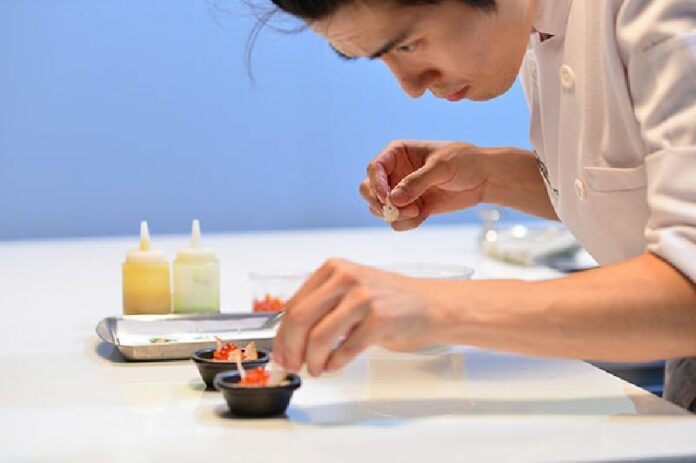
Any neophyte foodie – and there are plenty in Bangkok – knows red meat pairs with red wine; seafood pairs with white. But the sour notes of Japanese yuzu in Mikkeller’s Orange Yuzu Glad I Said Porter battling the sublime unctuousness of Wagyu beef? Sacrilege.
Purists wouldn’t pair the seemingly clashing flavors, but at Upstairs, defiance is the norm.
I arrive before service begins, as Chef Dan Bark, who cut his culinary chops under Chef Curtis Duffy (and his three Michelin stars) at Chicago’s Grace, sets up the open-kitchen in the corner of the small dining room. “You like Jame-O?” Dan asks, as the service staff huddles around a sterile prep station. He raises a shot glass and toasts to a successful night of service. Dan explains that this is his way of raising the team’s spirits and getting everyone excited about the night ahead, as if some of the world’s highest-rated beers and wildly inventive fare aren't enough.
A plate bursting with color lands in front of me, and before I can even make out the mess of greens, yellows, and reds, a glass of Mikkeller's Get Wit or Die Trying hits the table. The beer isn’t just served, it’s explained. A resident beer geek is on hand (which is pretty much everyone at this bar) to take diners through the finer points of the ales that accompany the food. Dan steps out from behind the kitchen with a smirk and asks if I’ve found the secret ingredient buried in the mess of taro, radish, and carrots that make up the first dish of the nine-course pairing dinner. “Your truffle game is on point, man” I replied.
The frenzied attention is on the young chef and his creations, but with typical Korean-American modesty, he credits the early success of the restaurant to his team, which includes his partner Fay, who heads up the front of the house.
At Upstairs, diners are actually sitting in a house. A former suburban-looking house converted into a beer epicenter-cum-fine dining operation.
Plating and garnishing of the fare are on full display, along with the dispensing of the beers from a row of six taps mounted flush to the wall. The pared-down dining room is small enough that you can hear the clamoring of knives and spatulas in the kitchen from any table.
“This is Whenever” Andrew says as he’s pouring out a brew that I’ve never seen or heard of before from a bottle. There’s a good reason it evades my beer-radar, the brew in question is produced specifically for The W Retreat Koh Samui by Mikkeller. The name refers to the timeframe when the lime leaf, ginger, and lemongrass pilsner is best consumed. Andrew acts as a sommelier would, explaining how the brews accentuate the cuisine and fielding questions that I’d usually reserve for an online beer forum. He handles the esoteric inquiries with ease. I snap a pic of the summery king crab dish next to the Whenever bottle bearing Mikkeller’s typical abstract and colorful branding.
To casual beer swillers, taking pictures of beer and worshipping hops and yeast must come across as lunacy. Even to the moneyed foodie crowd, wine is still king. That craft beer has made such inroads to fine dining in a city that, just years ago, was devoid of the stuff, is remarkable.
“There are a ton of great restaurants out there, and there are a ton of great beers, but so far they haven’t really come together in Asia,” explains Jakob Rasmussen, the man behind Mikkeller Bangkok “We’re excited to be the first ones in this space.”
But if there’s a time for Bangkok to outpace other global cities in a culinary race for inventive pairings, it’s now. The stage has been set. Craft beer in the kingdom has gone mainstream, with almost every trendy eatery hawking wares from importers like Mikkeller's own Hopsession.
Bangkok is also buzzing with dozens of new eateries with Michelin starred chefs behind them.
Big names have brought us into a brave new world of Bangkok fine dining. Savelberg Thailand, L’Atelier de Joël Robuchon, and even Vogue Lounge are lighting up the city’s gastronomic scene, but they’re largely bound by convention and tradition, while Upstairs is anything but conventional.
“Staying cool in really important in the kitchen.” Dan says. The chef practices Zen-like techniques to stay calm and collected in a kitchen where all eyes are on him. “I tell my team to visualize and anticipate every single movement they make, make sure every physical movement is purposeful.”
Halfway through the meal, a boiling siphon of amber broth sneaks onto the table as a pungent herbal aroma fills the air. In Bark’s kitchen, the wow factor reigns supreme. The broth is poured over a portion of zesty duck, clearly taking cues from Vietnam’s fabled pho. The beer in question is the legendary lambic Spontanframboos.
During the brewing process, the lambic is exposed to the bacteria and wild yeasts present in the atmosphere in order to kick-start fermentation (normal beer uses carefully selected yeasts). This method of fermentation creates an incredibly complex funk that’s augmented by the hefty dose of raspberries in this particular Spontanframboos lambic. The beer glows a pigeon blood red, like a rare ruby found in Burma’s Kachin State. The mouthfeel is that of raspberry jam, finishing with a dry, tart acidic bite.
This is the course where the whole idea of combining fantastic textures and flavors with beer became illuminated. The Spontanfromboos isn't a beer I would have on its own, but when it collides with the citrusy zing of the duck broth, something clicks. Tasting a bizarre style like lambic after cutting your teeth on the relatively safe IPAs of the previous five courses will widen your eyes. I’ve heard people use phrases like “phenol-y like the residue from a test tube,” “ester-ish,” even “wood chips and hay from a rotting barn” to describe beer, but I avoid those terms to get some distance from the overly zealous tenderfoots of the craft beer world.
To me it’s always made sense to compare beer and food flavors to surroundings and climate, and this particular pairing felt like sitting in the middle of a fragrant herb garden in Vietnam’s Hue during the dog days of summer. Of course the five beers from the previous courses had me a little loopy; heavy-hitting IPA at 6.8 percent can get the creative juices flowing.
Jakob tells me the secret to successful beer pairing is designing the dish around the beer – not the beer around the dish – because the former cannot be changed once it’s bottled or kegged.
“Dan is one of the few chefs I know who works backwards,” he says. “He designs his food to the beer.”
Thinking back to the ceremonial shot we slammed down before service, it’s clear that Chef Dan is the antithesis of the “precious” chefs that dominate the fine dining scene in Bangkok. And that’s exactly what it takes to bring the stratospheric fussiness of pairing food and beverages down to the growing segment of casual-yet-nuanced diners. It’s what separates the typical wine dinner, filled with crisply pressed suits and inflated egos, from the beer pairing dinner. And that’s why Upstairs works, because beer doesn’t have the same orotund undertones as wine, and the diners coming to Upstairs seek respite in the laid back atmosphere that Mikkeller’s has become known for.
But this is still very much a fine dining restaurant. As soon as I took out my phone to snap pictures of the rare ales to share with fellow beer nerds, a tray appeared on the table, one appropriately sized for hors d'oeuvre, but there was no food.
What was this? It’s a tray to rest your phone on so it doesn’t touch the table. Another Bangkok first.
Upstairs Mikkeler Bangkok is open 6:30pm to 10:30pm daily and is located just off Soi Ekkamai 10.










































